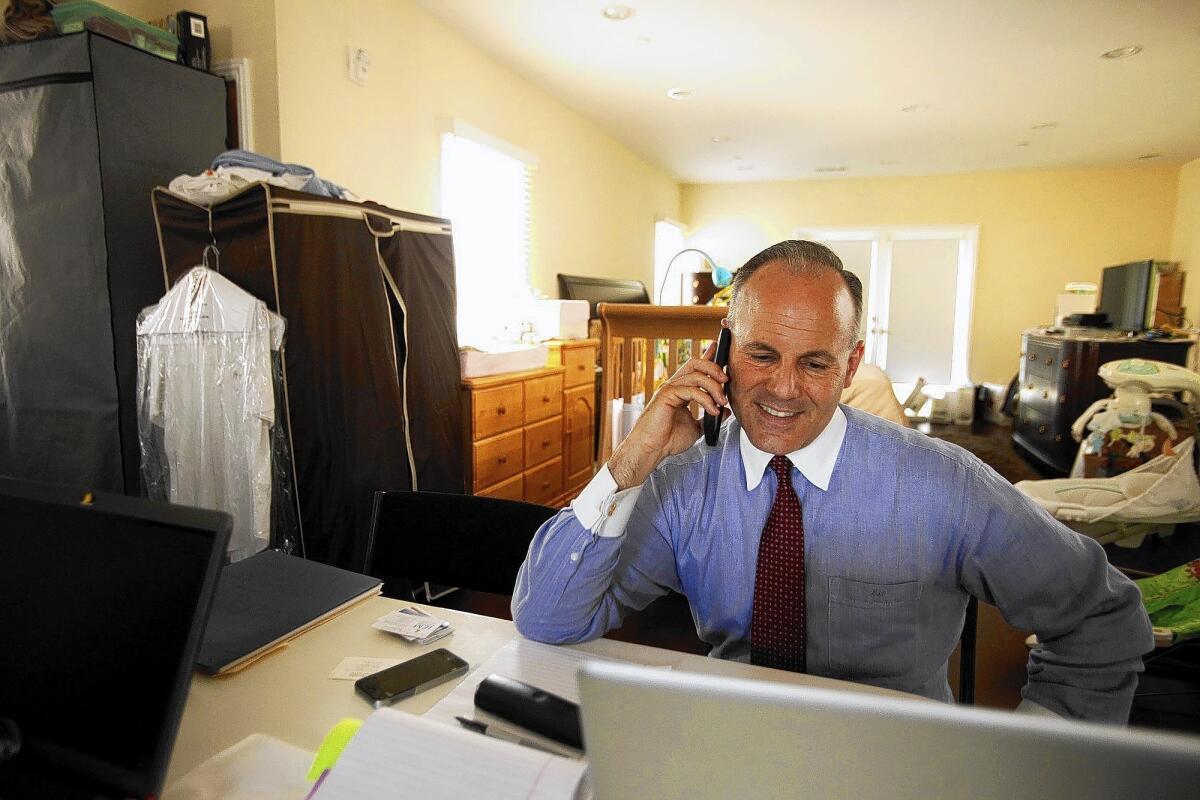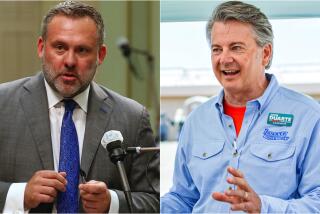Some of the hottest congressional campaigns do battle in California

- Share via
A Republican first-time candidate and a Democratic state senator from the South Bay emerged from Tuesday’s primary as the two fall contenders to succeed retiring Rep. Henry A. Waxman (D-Beverly Hills) in a liberal, wealthy, Westside-dominated congressional district.
With gang prosecutor Elan Carr and veteran elected official Ted Lieu placing first and second, respectively, the crowded primary ended the congressional hopes this year of three other close competitors for the Waxman seat, the center of one of the wealthiest, most politically active jurisdictions in the nation.
The intense competition stood out among a dozen or so of the hottest congressional races for one of the 53 seats in California’s House delegation.
The state’s top-two election system produced several same-party fall contests. All the candidates for a given office appear on the same primary ballot and only the first- and second-place finishers, regardless of any party affiliation, advance to the fall general election.
Among the same-party contests is the race to succeed retiring Rep. Howard P. “Buck” McKeon (R-Santa Clarita). Republicans Tony Strickland, a former state legislator, and state Sen. Steve Knight of Palmdale captured the two fall ballot places, edging out podiatrist Lee Rogers, a Democrat who ran against McKeon in 2012.
In Northern California, the bitter, high-spending battle between Rep. Mike Honda (D-San Jose) and his Democratic challenger, former Obama administration staffer Ro Khanna, will continue into the fall, while it appeared in incomplete returns that Rep. Eric Swalwell (D-Dublin) may have fended off a challenge from state Sen. Ellen Corbett (D-San Leandro) and likely will face Republican Hugh Bussell in November.
Other contests, in highly competitive districts, are likely battlegrounds in the national struggle between the two major parties. They include races involving five first-term House members, whose seats were held by a member of the rival party prior to their 2012 elections.
As the Nov. 4 general election approaches, the campaign arms of both parties are starting to make decisions about which seats to target with money, volunteers and other resources.
Rep. Scott Peters (D-San Diego) will face Republican Carl DeMaio, a former San Diego city councilman, in what many observers expect will be the most competitive race in California this fall.
Other vulnerable freshmen are Reps. Raul Ruiz (D-Palm Desert), who will face state Assemblyman Brian Nestande (R-Palm Desert); Ami Bera (D-Elk Grove), who will compete with former GOP Rep. Doug Ose; Julia Brownley (D-Westlake Village), who will face off with Assemblyman Jeff Gorell (R-Camarillo), and David Valadao (R-Hanford), who will be challenged by Democrat Amanda Renteria.
A handful of races remained too close to call Wednesday. They include the seven-candidate fight to succeed retiring Rep. Gary Miller (R-Rancho Cucamonga) in the Inland Empire. Democrats had expected to take the seat in 2012 but they splintered the vote among four of their own party members, enabling two Republicans to advance to the fall ballot.
Republican military veteran Paul Chabot finished first, according to election night returns. But Redlands Mayor Pete Aguilar and Colton attorney Eloise Gomez Reyes, both Democrats, and former Miller aide Lesli Gooch, a Republican, were in close contention for second place on the ballot.
Another close race is for second place in a Northern California seat held by Rep. Tom McClintock (R-Elk Grove). Republican Art Moore was battling with independent candidate Jeffrey D. Gerlach to take on McClintock.
The secretary of state considers a close race to be one in which the gap between second- and third-place finishers is less than two percentage points. The outcomes of these races might not be known for days or even weeks as elections officials finish counting all the qualified ballots that were not tallied on election night. They have until July 4.
The race to succeed Waxman drew national attention, in large part because of the 33rd District’s glitz and power and Waxman’s stature in Washington.
Many observers chalk up Carr’s first-place finish (21.5% to Lieu’s 19%) to the presence of 10 Democrats on the ballot, where Carr was one of just three Republicans and the only one with a substantial campaign. Democrats hold a 44%-27% registration edge and the district went for President Obama by 61% in 2012.
“Ironically, Ted Lieu has essentially won this seat by coming in second place,” said David Wasserman of the nonpartisan Cook Political Report.
But Carr said his strong finish shows voters “are looking for real alternatives.”
Lieu said he expects to win the seat this fall but “we’re taking nothing for granted” and will run “a positive campaign that focuses on my record.”
Former Los Angeles Controller Wendy Greuel, a Democrat, came in third, with 16.8%. Eric Garcetti defeated her for L.A. mayor last year.
Greuel congratulated Carr and Lieu and promised supporters she would stay “engaged and active in the political arena.”
Finishing behind Greuel in the 18-contender field, plus a write-in candidate, were spiritual teacher and bestselling author Marianne Williamson, an independent, with 12.9%, and radio host Matt Miller, a Democrat, with 12%. The race marked their first bids for elected office.
Times staff writers Martha Groves and Dan Weikel contributed to this report.
More to Read
Sign up for Essential California
The most important California stories and recommendations in your inbox every morning.
You may occasionally receive promotional content from the Los Angeles Times.











